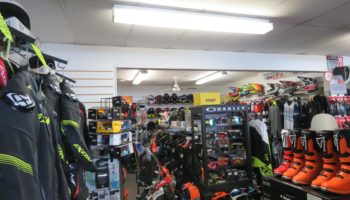Top MX Gear NZ: Prepare for Your Following Off-Road Journey
Top MX Gear NZ: Prepare for Your Following Off-Road Journey
Blog Article
A Detailed Appearance at Bike Components: What Every Motorcyclist Ought To Know
An extensive understanding of motorbike components is not merely helpful but crucial for any kind of biker intending to optimize performance and security. Each part, from the engine's complex operations to the reliability of brake systems, plays an essential role in the total experience and functionality of the bike.
Recognizing the Engine
The engine, frequently considered the heart of a bike, is a complicated setting up of parts that operate in consistency to convert gas right into activity. At its core, the engine's main feature entails the combustion procedure, where air and gas mix and stir up within the cylinders, resulting in controlled surges that drive the pistons. These pistons move up and down, transforming chemical power into power, which subsequently turns the crankshaft, inevitably powering the bike.

Understanding the details of a motorcycle engine is essential for bikers and enthusiasts alike. It not just gives insight into just how motorbikes attain their impressive power and rate however also help in effective maintenance and troubleshooting, ensuring longevity and reliability when driving.
Suspension Solutions
While the engine powers the motorcycle, the suspension system plays an essential duty in making sure a regulated and smooth ride. The suspension system is in charge of soaking up shocks from the roadway surface, keeping tire call, and offering security during cornering and stopping. It comprises two major components: the front forks and the back shock absorbers.
Front forks are typically telescopic, consisting of a spring and wetting device. The spring presses and prolongs to soak up bumps, while the moistening device controls the motion to avoid extreme jumping. This mix makes certain the front wheel remains touching the road, using remarkable handling and comfort.
The back suspension, usually a monoshock or twin-shock configuration, functions similarly to the front suspension however is customized to sustain the motorbike's weight and cyclist - motocross parts nz. It manages rear wheel activity, adding to the bike's total equilibrium and responsiveness
Suspension systems can be adjustable, enabling bikers to fine-tune preload, compression, and rebound settings according to personal preferences and riding conditions. This adjustability boosts performance by maximizing the bike's communication with diverse terrains. In summary, an efficient shock absorber is essential for rider comfort, safety and security, and the motorbike's taking care of expertise.
Brake Parts
Stopping power is a fundamental aspect of motorbike safety and security, and it rests on the performance of the brake parts. The main aspects of a motorcycle's stopping system consist of the brake pads, calipers, blades, and master cyndrical tube. motox parts nz. Each of these components plays a vital function in ensuring effective stopping performance
Brake pads are important as they create the essential rubbing versus the rotors to slow down or stop the bike. Created from materials such as sintered steel imp source or organic compounds, the selection of brake pad material substantially influences performance and longevity. Calipers, real estate the brake Clicking Here pads, apply stress to the pads when the brake bar is engaged, facilitating call with over at this website the rotors.
The rotors, normally made from stainless steel or actors iron, are installed to the wheels and serve as the surface against which the brake pads press. Their style, including size and thickness, affects heat dissipation and quiting power. The master cylinder, attached to the brake lever, creates hydraulic pressure sent with brake lines to the calipers, ensuring consistent stopping pressure.
Routine upkeep and evaluation of these components are essential for ideal performance, protecting against wear and guaranteeing cyclist safety and security on the road.
Tire Fundamentals
Beyond maintaining robust braking systems, making sure optimum tire efficiency is similarly considerable for motorcycle security and performance. Tires are the single contact factor in between the motorcycle and the roadway, making their condition essential in taking care of, security, and general experience high quality.

In addition, take into consideration the tire's age. Rubber compounds degrade with time, also if walk shows up ample. Check the sidewall for the DOT (Division of Transportation) code to establish the tire's age. Usually, replacement is suggested every five years, no matter of wear. Spending interest in these tire essentials not just optimizes performance yet additionally significantly improves riding security.
Electrical Solutions
In the world of motorbike upkeep, the electric system plays an important duty in making sure reputable performance and cyclist safety and security. This elaborate network includes important components such as the battery, generator, starter electric motor, and wiring harness. Each element is vital for the smooth procedure of the bike, from ignition to lighting and interaction with various sensing units.
The battery serves as the heart of the electrical system, providing the required power to start the engine and operate accessories. Regularly examining the battery's voltage and terminals for deterioration is essential to stop unanticipated failures. The generator, on the various other hand, charges the battery while the engine is running, ensuring a constant power supply.
To keep it, bikers should pay interest to any uncommon sounds or troubles during startup. Ensuring that the wires are cost-free and intact from damages is necessary for avoiding short circuits and making certain capability.
Conclusion

Quiting power is an essential element of motorcycle safety, and it hinges on the performance of the brake parts. The key components of a bike's stopping system include the brake pads, calipers, rotors, and master cyndrical tube.Brake pads are important as they create the essential friction against the rotors to reduce down or stop the motorcycle.Beyond maintaining durable braking systems, guaranteeing optimal tire efficiency is just as significant for motorcycle safety and performance.In the realm of motorcycle maintenance, the electric system plays an essential duty in making sure trustworthy performance and rider safety and security.
Report this page